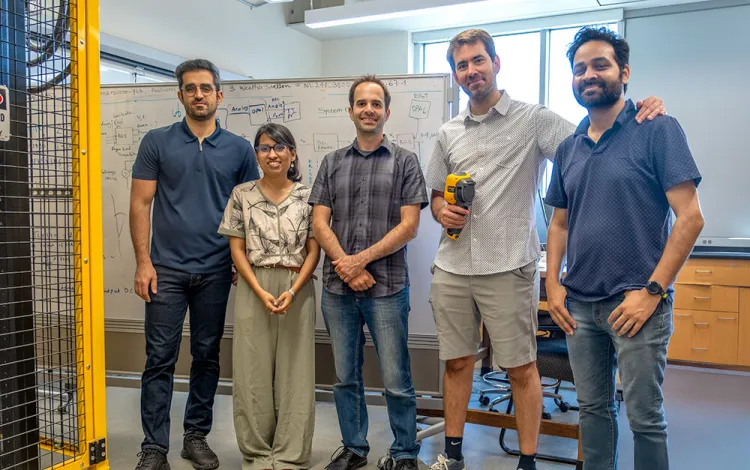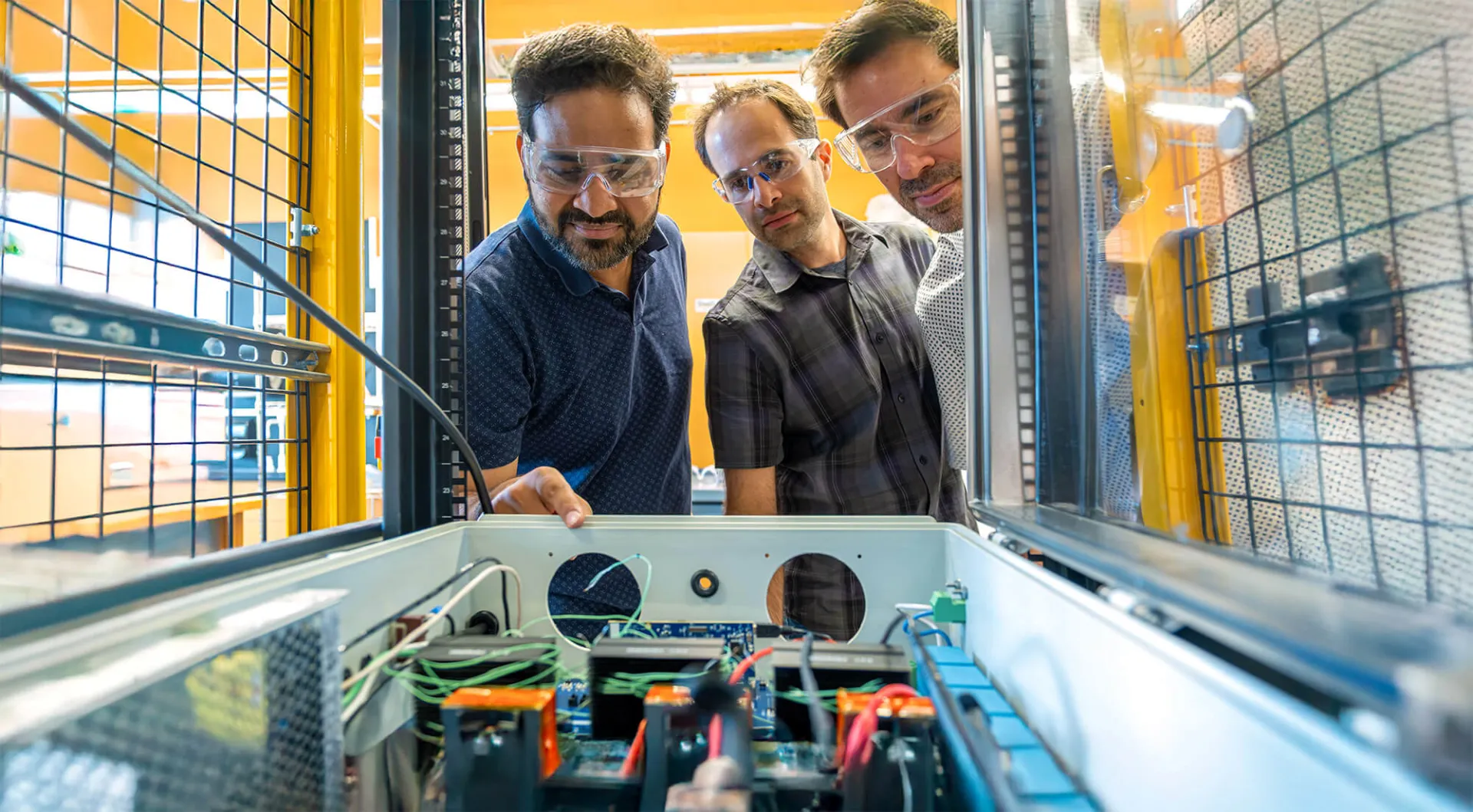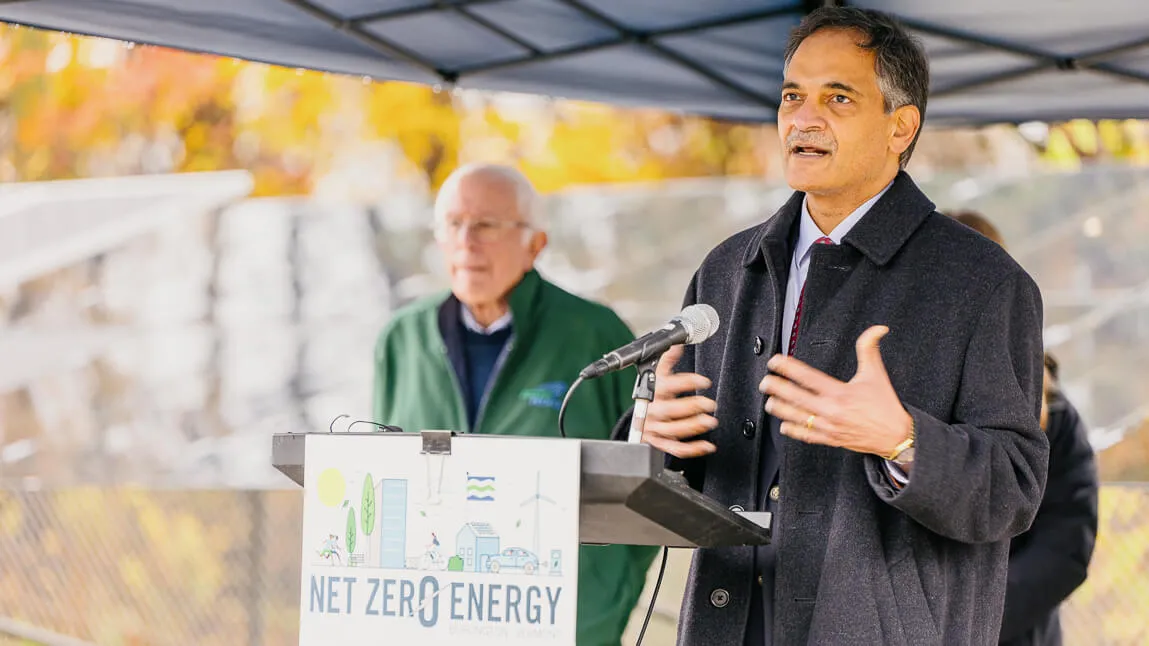The confidence we enjoy when we turn on any of the dozens of electrical devices plugged in throughout our homes and offices belies a growing challenge engineering researchers are facing to ensure it remains that way, with the complex interplay between expanding demand and the broadening role of clean energy sources that place unprecedented stress on the nation’s aging power infrastructure.
With support from the U.S. Department of Energy, UVM faculty and student researchers in the Center for Resilient Energy & Autonomous Technologies in Engineering (CREATE) have recently launched a new powerful laboratory in the University’s STEM complex that aims to accelerate the development of new grid technologies and advanced approaches to address many of the nation’s emerging energy challenges.
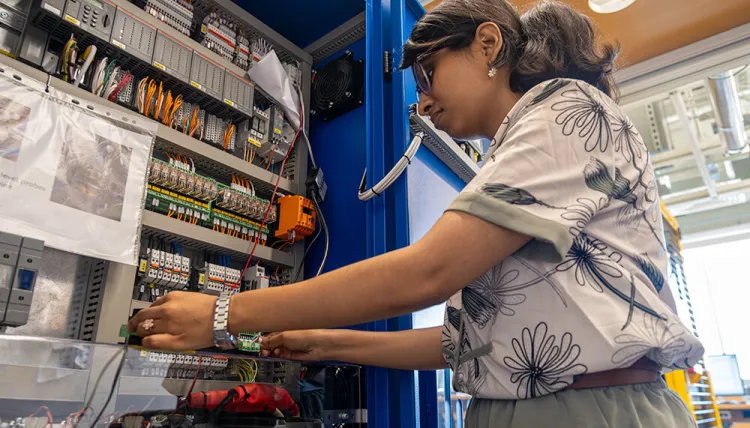
Aptly named the Accelerated Testing Lab (ATL), a team of CEMS faculty and graduate student researchers have spent much of the spring and summer setting up advanced equipment and systems to test, in real time, the control algorithms they’re developing for a wide range of energy research challenges.
Led by CREATE Executive Director Mads Almassalkhi and Co-director Hamid Ossareh, a research team composed of Research Associate Tanmay Mishra and Graduate Research Assistants Madiha Akbar and Arash Omidi have worked collaboratively to begin to explore the new hardware’s potential to expedite their research from white board brainstorming to functioning simulations and physical experiments.
“During the last couple of years, we have been working towards verification capabilities to test the algorithms we build and then loop these tests together with certain grid simulations,” said Almassalkhi. “We want to demonstrate real engineering impact as opposed to just academic study.”
Much of the focus for the new lab is on understanding the multifaceted impacts of integrating and controlling hybrid energy systems, which are systems that integrate various energy generation, storage, and conversion technologies, into the existing electrical grid. While the benefits of diversifying the grid with responsive hybrid energy systems—positive impacts such as reduced greenhouse gas emissions and enhanced energy independence from clean energy sources — the challenges for widespread implementation are complex and call into question the reliability and resilience of our current energy infrastructure.
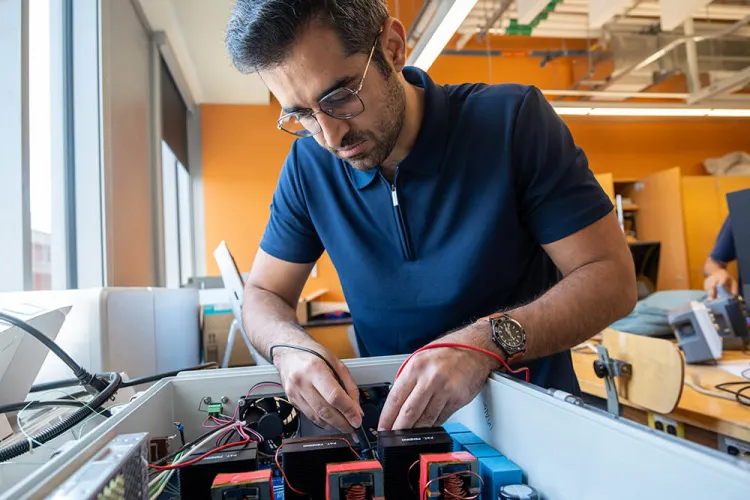
For example, both solar and wind energy generation systems are weather-dependent and subsequently variable, which can lead to fluctuations in power supply. As a result, modern electrical grids require additional flexibility, energy storage solutions, and sophisticated distributed energy resource management systems and controllers. As the renewable energy power generation ebbs and flows, our grid needs to be able to seamlessly store an influx of excess energy and then release that energy at the right time and place. Essentially, grid operators need to solve complex energy riddles in real-time, all the time, and the ATL helps CREATE researchers test Vermont-grown solutions to those riddles.
One new piece of equipment that will provide the ATL researchers with the ability to further explore energy storage solutions is the lab’s hydrogen electrolyzer—a device that uses electricity to split water into hydrogen and oxygen through a process called electrolysis. The hydrogen gas can then be stored to later be used as fuel, while the oxygen is usually vented and released. As compared to a battery, an electrolyzer can serve as part of long duration energy storage system, which can convert stored hydrogen back to electricity using fuel cell technology, or be used to fuel complex industrial processes, such as chip manufacturing plants.
Madiha Akbar’s research explores not only the potential for electrolyzers to store excess energy in the form of hydrogen but also considers other potential uses for the captured hydrogen gas, such as its value to the gas industry and electric vehicles that run on hydrogen fuel cells.
“We're crossing that analog/digital domain with not just the signals but also the ideas.”
—Mads R. Almassalkhi, CREATE Executive Director,
Associate Professor, Electrical and Computer Engineering
Another product of the electrolysis process is heat. As Akbar describes it, “hydrogen and oxygen are produced at a higher pressure and higher temperatures, releasing a lot of heat. Is there a way that we can utilize the heat, for example, in cold weather to melt the snow off solar panels and increase their efficiency? These are all areas of study that we are trying to focus our research on.”
Nearby, Omidi is engineering new methods to integrate battery energy storage with hybrid energy systems operations through control systems that both monitor and optimize the function of the batteries under a number of different scenarios. The ATL features an adjustable cold chamber that mimics conditions during a Vermont winter, allowing researchers to test and validate how their battery models and control strategies perform in real‑world conditions.
“By running hardware tests, we can examine different scenarios with grid simulations and see how the batteries can provide different grid services,” said Omidi. “For example, we can test how well batteries can smooth fluctuations from solar PV and supply the grid with reliable power.”
For solar PV testing, the ATL benefits from an ongoing partnership with Burlington’s McNeil Generating Station, Burlington Electric Department, and UVM’s Hybrid Solar Test Center (HSTC) Facility, which is housed there. Being able to access real-time data from the McNeil solar PV array, ATL’s researchers have endless opportunities to build out digital twin models, where variables can be manipulated to compare outcomes and further refine models and control algorithms.
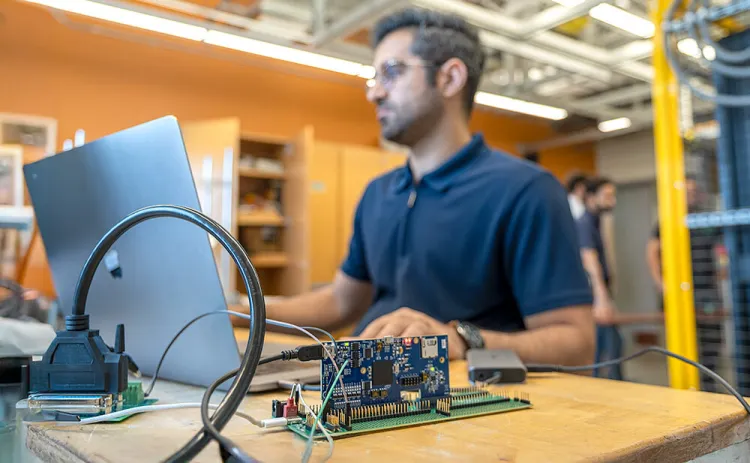
Integrating batteries as components in electrical grids introduces the need for inverter controls to convert the battery’s DC or “Direct Current” power to the grid’s AC or “Alternating Current” requirements. At the ATL, research associate Tanmay Mishra and his colleagues have developed a hardware‑in‑the‑loop (HIL) simulation testbed with multiple 3‑phase, 5‑kVA inverters to test and validate both grid‑following and grid‑forming control algorithms that are embedded on physical control boards. The testbed has already given senior electrical and computer engineering students Emily Ninestein and Alec Benedict — who worked in the ATL on their SEED project with Vermont’s transmission utility, VELCO — first-hand experience with HIL simulations, grid modeling, and software tools. That experience directly helped them secure full-time positions as transmission planners at ISO New England.
Essential for balancing supply and demand and to ensure the grid continues to operate safely, efficiently, and reliably, controllers ultimately enable the automation and smart operation of the grid. “We combine all the expertise in electrical & computer engineering to design our own advanced control algorithms,” said Akbar, who added, “This is the core or heart of the system that connects everything.”
“You can’t have power without control,” says Co‑Director Hamid Ossareh. “Autonomy is the glue that holds together nearly every modern technology we rely on — from aircraft and cars to phones and power grids. At ATL, we’re showing students and researchers how essential that glue is for building the next generation of resilient, flexible energy systems.”
The lab’s new hardware was funded by a large interdisciplinary project supported by the U.S. Department of Energy and being led by Mads Almassalkhi together with colleagues from Electrical & Computer Engineering (professors Hamid Ossareh, Amritanshu Pandey and Samuel Chevalier), Mechanical Engineering (Professor Jeff Marshall), and Physics (Associate Professor Matt White). The aims of the Hybrid Energy System Platform (HES) for Cold Weather Climates project is to create advanced computational tools for a hybrid energy system by combining physics-based and data-driven approaches utilizing laboratory testing, data collection, and field demonstrations.
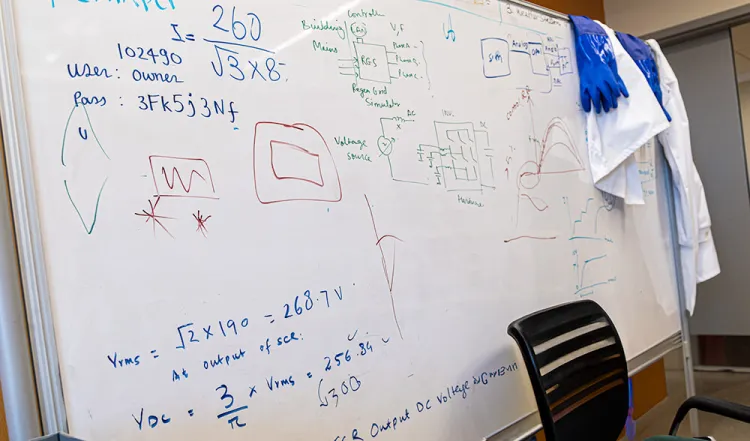
CREATE
An interdisciplinary research center focused on advancing the next generation of energy and autonomous technologies, The Center for Resilient Energy & Autonomous Technologies in Engineering (CREATE) was formed in 2024 to develop solutions for the complex challenges that exist at the intersection of technologies that enable resilient and responsive power and energy systems, as well as data-driven feedback control solutions.
While many of CREATE’s research initiatives have transformational potential for the energy and autonomy industries, Almassalkhi and Ossareh see the real benefit of labs like ATL in developing future engineers and scientists with the skills to ensure a sustainable energy future. As Almassalkhi described, “Our real products are the people. It's not really the papers. It's not really the patents. It really is the people.”
